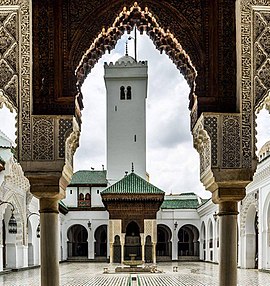| Universidad de Qarawiyyin | ||
|---|---|---|
 | ||
| Forma parte de | Medina de Fez | |
| Fundación | 859 | |
| Fundador | Fatima al-Fihri | |
| Localización | ||
| Dirección | Fez, Marruecos | |
| Coordenadas | 34°03′52″N 4°58′24″O / 34.064444444444, -4.9733333333333 | |
| Sitio web | ||
| http://uaq.ma/ | ||
La Universidad de Qarawiyyin o Al-Karaouine (en árabe جامعة القرويين) ,(la universidad más antigua del mundo),es una universidad islámica y mezquita ubicada en la ciudad de Fez, Marruecos. Esta institución fue fundada como madrasa de Qarawiyyin en el año 859,[1][2] durante el reinado de la dinastía idrisí, por dos mujeres tunecinas, una de ellas Fátima al-Fihri, originarias de la ciudad de Cairuán (en árabe Qairawan), que era por entonces la capital de Túnez... Las bellas residencias de los estudiantes todavía se hallan alrededor de la universidad y fueron restauradas por el gobierno de Marruecos. gobierno de Marruecos.
Se incorporó al moderno sistema universitario estatal de Marruecos en 1963 y pasó a llamarse oficialmente "Universidad de Al Quaraouiyine" dos años más tarde.[3]
Es la institución universitaria más antigua todavía en funcionamiento por la Unesco[4] y el Libro Guinness de los récords.[5][6][7][8][9]
- ↑ Andrew Petersen: "Dictionary of Islamic architecture, Routledge", 1996, ISBN 9780415060844, p. 87: Al Karaouine fue fundada en 859 como mezquita:
The Qarawiyyin Mosque, founded in 859, is the most famous mosque of Morocco and attracted continuous investment by Muslim rulers.
- ↑ Esposito, John (2003). The Oxford Dictionary of Islam. Oxford University Press. p. 328. ISBN 0-1951-2559-2.
- ↑ Lulat, Y. G.-M.: A History Of African Higher Education From Antiquity To The Present: A Critical Synthesis Studies in Higher Education, Greenwood Publishing Group, 2005, ISBN 978-0-313-32061-3, p. 70:
As for the nature of its curriculum, it was typical of other major madrasahs such as al-Azhar and Al Qarawiyyin, though many of the texts used at the institution came from Muslim Spain [...] Al-Qarawiyyin began its life as a small mosque constructed in 859 C.E. by means of an endowment bequeathed by a wealthy woman of much piety, Fatima bint Muhammed al-Fahri.
- ↑ [1]
- ↑ The Guinness Book of Records, 1998, ISBN 0-553-57895-2, P.242
- ↑ Nuria Sanz, Sjur Bergan (eds.): The Heritage of European Universities, Council of Europe, 2002, ISBN 92-871-4960-7, p. 119:
In many respects, if there is any institution that Europe can justifiably claim as one of its own inventions, it is the university. As proof thereof and without wishing here to recount the whole history of the birth of universities, it will suffice to describe briefly how the invention of universities took the form of a polycentric process of specifically European origin.
- ↑ Rüegg, Walter: "Foreword. The University as a European Institution", in: Ridder-Symoens, Hilde de (ed.): A History of the University in Europe. Vol. I: Universities in the Middle Ages, Cambridge University Press, 1992, ISBN 0-521-36105-2, pp. XIX–XX:
The university is a European institution; indeed, it is the European institution par excellence. There are various reasons for this assertion. As a community of teachers and taught, accorded certain rights, such as administrative autonomy and the determination and realization of curricula (courses of study) and of the objectives of research as well as the award of publicly recognized degrees, it is a creation of medieval Europe, which was the Europe of papal Christianity...No other European institution has spread over the entire world in the way in which the traditional form of the European university has done. The degrees awarded by European universities – the bachelor's degree, the licentiate, the master's degree, and the doctorate – have been adopted in the most diverse societies throughout the world. The four medieval faculties of artes – variously called philosophy, letters, arts, arts and sciences, and humanities – law, medicine, and theology have survived and have been supplemented by numerous disciplines, particularly the social sciences and technological studies, but they remain none the less at the heart of universities throughout the world. Even the name of the universitas, which in the Middle Ages was applied to corporate bodies of the most diverse sorts and was accordingly applied to the corporate organization of teachers and students, has in the course of centuries been given a more particular focus: the university, as a universitas litterarum, has since the eighteenth century been the intellectual institution which cultivates and transmits the entire corpus of methodically studied intellectual disciplines.
- ↑ George Makdisi: "Madrasa and University in the Middle Ages", Studia Islamica, No. 32 (1970), pp. 255-264 (264):
Thus the university, as a form of social organization, was peculiar to medieval Europe. Later, it was exported to all parts of the world, including the Muslim East; and it has remained with us down to the present day. But back in the Middle Ages, outside of Europe, there was nothing anything quite like it anywhere.
- ↑ Kevin Shillington: "Encyclopedia of African history", Vol. 1, New York: Taylor & Francis Group, 2005, ISBN 1579582451, p.1025